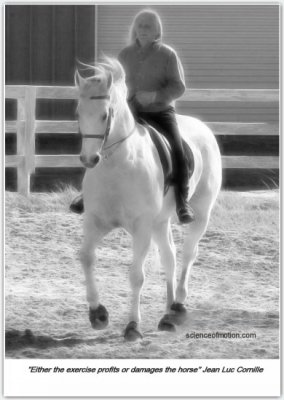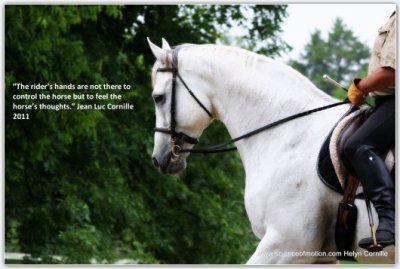Chazot Thoughts 57
Chazot Thoughts 57
Classical Umbrella

“Because we have viewed other animals through the myopic lens of our self-importance, we have misperceived who and what they are. Because we have repeated our ignorance, one to the other, we have mistaken it for knowledge.”
(Tom Regan)
Your ancestors and in particular the ones who had enough culture to write about their experiences, always have been at the cutting edge of scientific knowledge. In 1731, François Robichon de la Gueriniere, wrote about perfecting the art with the help of science. In 1877, Lenoble du Teil published a study on equine locomotion. In 1949, General Decarpentry explores the concept of storage and reuse of energy in our lower legs long tendons. Deprive of adequate scientific research, they use metaphors, paraphrases explaining their though, describing their feeling and observations. When literature explains physics, many interpretations can be made and since equine biomechanics is physics, interaction of forces and consequent actions, many interpretations have been made, some close to actual knowledge, other contradicted by actual knowledge.
Actual knowledge of our functional anatomy, bones and muscles architecture restores, in some instance the real meaning of your ancestors’ thoughts. Actual knowledge also explains how words have in other instances, led to misconceptions. Using a technology known as accelerometers, Anton van den Bogert and he measured the vertical forces induced on the horse’s back at the walk and at the trot, with and without a rider. The sensors measured the sum of vertical forces and therefore the forces created by our limbs and the forces created by our back muscles. They were surprised by the amount of upward forces recorded by the sensors. However, a great part of it was created by our hind and front legs. “In horses, and most other mammalian quadrupeds, 57% of the vertical impulse is applied through the thoracic limbs, and only 43% through the hind limbs.” Your ancestors did not have the technology to distinguish the upward forces produced by our limbs and the forces created by our back. They interpreted the sum of upward forces as being movements of our back and they created the theory of the swinging back.
In fact, modern technology further explains classical misconceptions in general and the misconception of the swinging back in particular. For the experiment, Anton and he, placed seven sensors on the horse’s back. The computer screen showed seven dots connected to each other by a line. As the horse was in motion, the dots moved up and in respect of the upward forces that they registered. It looked on the screen exactly like the swinging back that your ancestors described. Anton van den Bogert, who was running the experiment specified, “You are not watching movements of the vertebral column. You are watching a computer illustration of upward forces”. Watching the dots on the screen, he was thinking, “No wonder why our ancestors believed that it was a swinging motion of the thoracolumbar spine”. Feeling is only a perception and as long as feeling is not translated in the brain in respect of the real picture, feeling has led and continue to lead to misconceptions.
Quite often equine literature and equine physics collide and the ones who see the horse world through the words of your ancestors, use “Classical” as an umbrella against new understanding of equine physics. Occasionally, angry dummies accuse him of “big words,” they want him to explain complex laws of physics in lay terms and one paragraph, they drop the names of famous classical authors as proof of their beliefs. Instead of benefit from new knowledge and therefore respect the spirit of your ancestors, they use words and the meaning usually associated with the words as an umbrella against a different understanding of the same word, updated to actual knowledge. The problem is that we do not perform with words; we perform with forces. We can understand brief voice commands and even words such as “walk” or “canter” or “turn”, but we cannot properly and therefore soundly coordinate our physique for the gait or the effort.
The same inaptness applies to what you call, “obedience of the rider’s aids”. For us, your aids are just stimulus associated in our memory with given responses. Your ”aids” are just formulas They are not the subtle and sophisticated dialogue that can lead our mental processing toward optimum coordination of our physique. From our equine perspective, we view the study of your aids as a learning process allowing you to gradually understand how different part of your physique influences our body. This is part of your elementary education. The next step is moving beyond formulas and using your whole body together as a language. Formulas, can only stimulate approximated gestures. In order for us to learn how to orchestrate optimally our physique for the move, we need a rich and subtle dialogue. We perceive sophisticated nuances in your muscle tone. This is our comfort zone. We are willing to dialogue at this level of sophistication. Instead we turn instinctively into protective reflex contraction when the dialogue became submission to your so called “aids”. Nuances in muscle tone leading our mental processing toward optimal coordination of our physique is what classic equitation is about. Submitting us to formulas is not classic; it is archaic. General Decarpentry wrote, “Hand movements diminish as dressage progresses to the point of giving an illusion of immobility.” (Academic Equitation, J. A. Allen & CO LTD. 1971 p. 44) One can interpret the author reflection at the letter, less hand movements, or update it to actual knowledge.
This picture and the quote summarizes actual knowledge. Lightness is not the bit; lightness is the outcome of a sophisticated coordination of our physique allowing light and subtle contact on the bit.  The softness and the stability of your hands refines the perception of our dialogue. There is no longer “hands movements”’ your hands are sensors providing insight about our body state. Your hands are part of your perceptual capacities. During our mental research toward optimum orchestration of our physique, your hands feel our errors. Our neck multiplies minute movements of our body and you can feel through your hands minute changes in our body. We do not achieve balance control with our mouth. We eat grass, with our mouth, drinks water with our mouth but we control our balance through sophisticate coordination of our physique. Our tongue and your fingers are part of a subtle dialogue. If you properly control your own balance. If you have a stable seat and therefore soft forearms and fingers, we have, through the bit, a precise and soft dialogue. Your task is then using your brain’s capacity of analysis and help us in suggesting appropriated insights or adjustments.
The softness and the stability of your hands refines the perception of our dialogue. There is no longer “hands movements”’ your hands are sensors providing insight about our body state. Your hands are part of your perceptual capacities. During our mental research toward optimum orchestration of our physique, your hands feel our errors. Our neck multiplies minute movements of our body and you can feel through your hands minute changes in our body. We do not achieve balance control with our mouth. We eat grass, with our mouth, drinks water with our mouth but we control our balance through sophisticate coordination of our physique. Our tongue and your fingers are part of a subtle dialogue. If you properly control your own balance. If you have a stable seat and therefore soft forearms and fingers, we have, through the bit, a precise and soft dialogue. Your task is then using your brain’s capacity of analysis and help us in suggesting appropriated insights or adjustments.
Such level of sophistication is not the privilege of a few of us and very rare riders. It is our comfort zone and is accessible by many riders as long as riders regard “correct aids” as part of their equestrian education instead of the finality of their education. An equitation based on gestures and formulas is limitative, both at the level of perception as well as communication. It also dumbs down your mental processing. Instead of interpreting our reactions as information about our current body state, you judge our reactions in respect of your stereotypes. This is not classical; this is empirical. This is not the equestrian art where two athletes work in harmony. This is slavery where one submits in order to survive.
Any living creature is composed of systems within a system within a system. At superficial level, we might submit to the rider’s aids but at the level of deeper layers we function on survival mode. Only when our brain is engaged in the process of refining our body coordination for greater efficiency and therefore ease and effortlessness, our whole systems, down to microscopic level achieve optimum orchestration.
Chazot
Jean Luc Cornille
Keep your horse sound Click IHTC Course to learn how



 twitter
twitter facebook
facebook delicious
delicious google
google stumbleupon
stumbleupon tumblr
tumblr pinterest
pinterest yahoo
yahoo linkedin
linkedin